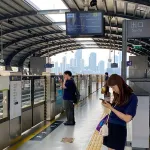Copyright macaudailytimes

Light Rapid Transit (LRT) usage among young people in Macau remains low compared to other transportation options, primarily due to insufficient network coverage, and the government has yet to respond to the relevant survey report. The Macao New Chinese Youth Association conducted a street survey on Macau’s LRT service earlier this year, receiving responses from 647 youths aged 18 to 44. According to the group, during the survey period, the research team collaborated with members of relevant government advisory bodies to organize field visits for young people to various LRT stations and their supporting facilities, including Barra Station and Hengqin Station. They also engaged in discussions with LRT company representatives, gathering diverse opinions through on-site exchanges. According to the findings released at yesterday’s press conference at the group’s office, nearly 60% of young respondents had ridden the LRT in the past year; however, 70% of these riders used it once every three months or less, categorizing them as infrequent users. Only 1.5% of respondents relied on the LRT as their primary mode of transportation, while just 11.1% and 4.5% of those who had ridden the LRT within the past year used it for commuting to work or school, respectively. Despite a significant increase in the utilization rate of the LRT system over the past year, with ridership reaching approximately 5.37 million trips – a 117% increase from the previous year – September’s average daily ridership reached 30,600, setting a new record since full-fare operations began. However, the survey released yesterday indicates that Macau’s youth still primarily rely on buses, walking, or driving for transportation, even to key destinations such as the city’s airport, Hengqin checkpoint, Cotai, and central Taipa. The primary reason for choosing the LRT was “purely for the experience,” with 33.9% of respondents citing this. Additionally, the findings noted that on a five-point scale, nearly 42% of respondents gave low ratings of one or two points, indicating that insufficient network coverage is currently the LRT’s most critical issue. The policy objective for public transportation in Macau is to prioritize “LRT as the mainstay, with buses as a supplement.” However, survey results indicate that young people have reservations about this direction, with 37.2% of respondents expressing disagreement. While respondents widely believe that the lack of network coverage in core residential areas –such as the distance from stations to residences and the inability to reach destinations directly – is the primary factor affecting their willingness to use the service, it is noted that over 70% of young respondents believe the LRT should be further developed after the completion of its East Line. Also 75% support the planned West Line extension northward from Barra Station to serve the city’s old quarters, including the Inner Harbor area. Respondents expressed additional expectations for LRT development, including the introduction of more convenient payment methods such as QR codes and contactless credit card tapping for fare collection, the launch of an official mobile application, and the promotion of integrated ticketing between light rail and bus services. Meanwhile, leasing for commercial facilities at Barra Station began early last year. Recent observations by the Times indicate that some merchants have already opened shops selling local cultural and creative products, while leasing advertisements remain posted within the station. Based on the findings, where nearly 60% of respondents expressed a desire for LRT stations to include convenient commercial facilities like convenience stores, the association proposed yesterday that the government establish a youth entrepreneurship support program to encourage local youth cultural and creative brands, as well as light food and beverage outlets, to set up shop in LRT stations. Regarding the survey on youth entrepreneurship support programs and whether young people intend to start businesses in this environment, the group indicated that relevant information may be included in future research reports. “Consequently, this report primarily focuses on understanding the current state of the transportation system and proposing recommendations,” a representative said.



